Canadian Mennonite women were among millions who peacefully made their voices heard for justice, equality and a host of social causes at the Women’s Marches that took place across Canada and every continent on January 21, 2017, the day following the Donald Trump inauguration.
Some even made it all the way to Washington, D.C., where hundreds of Mennonites arrived in buses, by plane, train and car to join in a massive, peaceful gathering estimated at more than half a million, which far exceeded expectations and led to human gridlock in the core area of the city.
Thea Armstrong, 15, who attends Breslau (Ont.) Mennonite Church, asked for the trip as a Christmas present and travelled by car with her mother, Rockway Mennonite Collegiate teacher Marlys Neufeldt, and sister Siena, 17. The group was invited to stay in the home of a member of the Mennonite-affiliated Washington Community Fellowship Church, after connecting through a Facebook group called Mennonites at the Women’s March in Washington.
“It was important to me, as someone who’s going to be affected [by social justice issues raised by the U.S. election] for the rest of my life, even living in Canada, because Canada is so close to the U.S.,” Thea said after the march. “I found it to be really unifying. I loved the number of people that showed up—that was really awesome, that there were so many people so committed. I found it to be really empowering to be surrounded by people who were all worried about the future and taking a stand and not being silenced.”
Speakers included an “intersectional” diversity of voices not often heard in the mainstream, Siena said, everyone from kids worried about their immigrant parents being deported, to Muslim women; Palestinian, Hispanic and Native Americans; environmentalists; sexual abuse survivors; transgender people; black women who’d seen their sons killed by police, and many others fearful of dark forces the Trump election seems to have unleashed in the public mindset.
“There were some celebrities, but there were a lot of people who don’t have such a mainstream voice,” she said. There were also lots of supportive men, of all races, sharing the message of working together for a more just, peaceful, loving and equitable society.
“I was really glad that my daughter encouraged me to go, not just to a closer city but the one that was at the nucleus of the power change, and to use our power to confront the power in government and present an alternative message of peace and equity for all,” said Neufeldt. She explained that having once lived in the U.S. for almost three years and having many American friends added to her sense of connection. “The fact that marches were going on in cities all around the world was really empowering; it felt almost like a new wave of feminism.
“I’m really inspired and encouraged by my daughters that they wanted to be part of this, and I want to encourage them to become young activists, which they already are,” she added.
Wendy Chapell-Dick of Bluffton, Ohio, who created the Mennonite women’s Facebook group, was instrumental in helping participants communicate with each other and organize buses and accommodation, although in the end the hope of marching as one group was thwarted by the sheer size of the crowds and jammed cellphone signals.
Buses were organized from Bluffton, Ohio; Lancaster, Pa.; Harrisonburg, Va.; Goshen, Ind.; and other cities with large Mennonite populations. Many other participants came on their own.
“I’m sure there were several hundred (at the march), but there was no way we could find each other because we couldn’t move!” Chappell-Dick said, reflecting on what proved to be a difficult, yet exciting and historic day. Being Mennonite, it came naturally for some of the group to spend an hour at the gathering point singing together before going to the rally site—songs like “The Journey is Long” and “Over My Head”—to appreciative response and participation from the crowds flowing around them.
“It was heartwarming,” Chappell-Dick said. “It wasn’t all of the group, but it was enough that we could make some noise.”
Despite the difficulties of the day, she was pleasantly surprised with the turnout. “I think the fact that so many came says a lot about Mennonite women that we need to pay attention to. Not just women who came here, but to sister marches. And the women who knit us these caps”—the pink hats that became a cheeky staple of the marches. “I received three boxes in the mail from Mennonite women who were knitting these hats. Over 20 women came to me to offer money to help others go, Mennonite women. It touched something. Somehow it was important to us and struck a chord.”
Speaker after speaker on the four-hour program reflected on the need to do more than just march or hit “send,” urging participants to go home and work for the good of their communities, to organize for better political solutions and to overcome prejudice, injustice, misogyny and oppression of marginalized people with loving action. One indication of the positive, affirming atmosphere among the enormous crowd was the fact that police didn’t make a single arrest throughout the long day.
Melanie Penner, an autism clinician investigator who teaches at the University of Toronto and attends Toronto United Mennonite Church, flew to Washington to attend the march and thought about how Mennonites need to take seriously the voices of marginalized people, even when they make us uncomfortable.
“I felt so proud to have participated in the Women’s March,” she said in a written reflection later. “The Mennonite in me was happy to affirm the value of non-violent resistance. ‘Congratulations, you!’ I told myself. And then I returned home and returned to social media. I read about how women of colour were treated at the march, being told they weren’t being inclusive enough for reminding people that the majority of white women voted for the current president of the United States.”
Penner writes, “I did not see any police in riot gear in Washington, and hardly saw any police at all. I did not have to choose non-violence; non-violence chose me because I am white, and the majority of people marching were also white.
“Like the march, our composition as Mennonites is largely white. Though our shared history is one of being outsiders and oppressed, those of us with white skin now enjoy the privilege that goes along with it. A look through the Beatitudes is a reminder of this. It is time to give the blessed ones—the mourning, the persecuted, the reviled—their time on the platform. If they do not have a platform, we must build it for them and lift them up to the microphone. If they tell us we are wrong, we must humbly repent. We will not back down; we will clear the way,” Penner wrote.
Being able to march behind a “Mennonites” banner with a group whose messages reflected an Anabaptist perspective was great, Thea Armstrong said. “A lot of the signs [carried in the march] were kind of contradictory to the idea of fighting hatred with peace and love, and marching with Mennonites was very affirmative of being kind and taking a stance in a nonviolent way.”
Among the many positive messages hoisted high by the Mennonite group were the popular trilingual “We’re glad you’re our neighbor” signs.
“It was cool being with a group that shares your views on how to bring about change, in a peaceful and loving way,” Siena Armstrong added. “And to get to know people who are from a different country than you. They were so happy to see you, which was really cool. And it was such a huge group of people united in this one cause. . . . Especially being in Washington, it felt more effective, maybe. To be in the place where the inauguration had just happened. We could see the ‘aftermath’ of it.”
Chappell-Dick says she hopes the Facebook group continues to be a place to share experiences and responses to the marches, and “to become even a more real connection than we managed to create here.”
—Corrected Jan. 25, 2017
For perspectives from the U. S. see:
Mennonites join Women’s March on Washington (Mennonite World Review)
Mennonites join the Women’s March on Washington (The Mennonite)
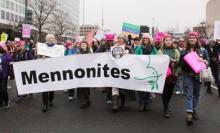
Canadian Mennonites Marlys Neufeldt, third from right, and her daughters Siena Armstrong, second from right, and Thea Armstrong, right, take part in the Washington Women’s March on Jan. 21, along with Mennonite marchers from the U.S. (Photo by Doreen Martens)
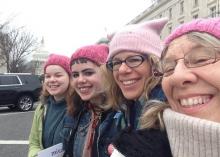
Pictured from left to right wearing their symbolic pink ‘pussyhats’: Siena Armstrong, Thea Armstrong, their mother Marlys Neufeldt, and Doreen Martens pause for a selfie during the Women’s March in Washington, D.C., on Jan. 21, 2017. A friend made their hats and gave them extra ones, which they shared with people in Washington. (Photo by Doreen Martens)
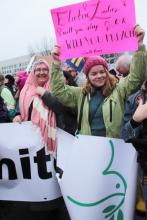
Siena Armstrong holds up a sign she and her sister Thea made for the Women’s March on Washington. It quotes the lyrics from a Janelle Monáe song: ‘Electric ladies: Will you sleep or will u preach?’ Monáe performed at the march with shout-outs to black women and the mothers of black women who have been previously shot by police. (Photo by Doreen Martens)

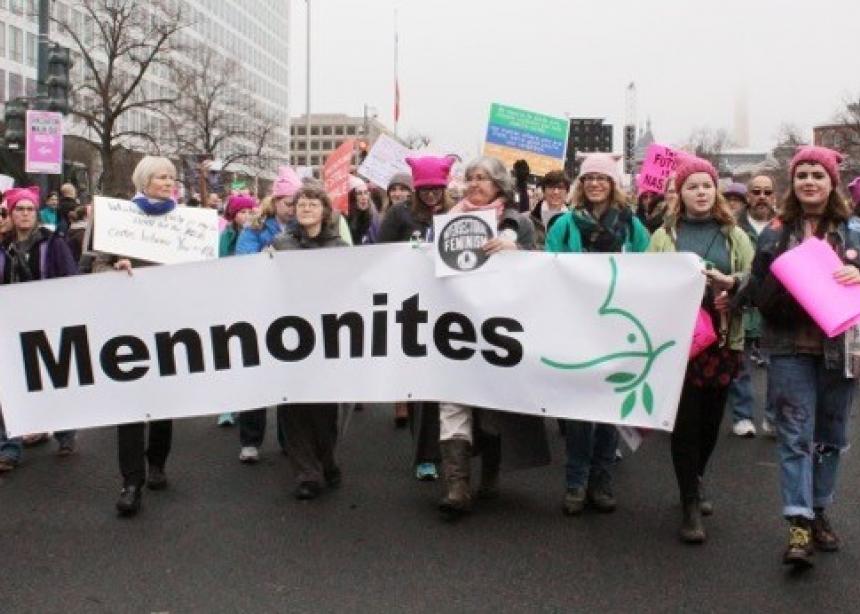
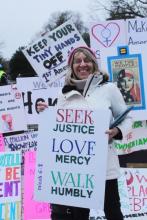
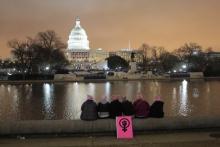
Comments
How many years have Christians in North America prayed that abortions would be outlawed and seen as killing helpless children. I find it incomprehensible that "peace-loving" Mennonites, or other so-called Christians would support a presidential candidate who publicly advocated for free abortions right up to the time of birth. She lost the election because many Christian women saw the light and voted against her. Finally a candidate came along, certainly not likable in many respects, but who had the courage to stand up against this horrible wrong and confront the massive massacre of the innocents.
Since the abortions were legalized, statistics show that at least 50 million abortions have taken place. The Obama administration extended the rights to women past 20 weeks of pregnancy, though I'm not sure if "Obama care" covered the costs right up to birth.
And another question: where were the Mennonite women the following Saturday, when the March for Life took place in Washington? No demonstrations in Canada, and yet the March was addressed by Vice-President Pence, a man who openly confesses Jesus as his Lord and Saviour. Why was nothing written about it in "Canadian Mennonite"?
Do we pay lip-service to Jesus, or are we committed to serve him as Lord? Perhaps many women should read the book "Forgiven of murder," by Denise Mountenay. She had three abortions before the Lord Jesus met her and she saw the wrong she had committed.
While there was cheering and celebration in Washington on January 21, I am sure all of heaven was weeping. How Satan has moved into the church and blinded its members! May the Lord forgive us for the horrible sins committed!
The photos attached to this story raise a very serious issue. Namely, how exactly did this group gain access to the Mennonite Church logo to be used on a large banner claiming to represent all Mennonites? Were they acting formally on behalf of MC Canada and/or MC USA and thus given permission to use the logo? If not, they should be immediately disciplined for attempting to represent the denomination(s) without authorization.
I formally call upon Willard Metzger of MC Canada to investigate this issue and provide an explanation for how this happened, and what discipline will be levied as a result, should it be determined the group acted without permission. In the corporate world such unauthorized use of company branding would assuredly result in a lawsuit. In the church context, at very least there should be a call for repentance and discipline. Despite what the participants proudly claim, they do not speak for the majority of Mennonites/Anabaptists on the issues represented by this often vulgar event in Washington.
It is very clear from the banner that the group was not claiming to march on behalf of a particular Mennonite organization. All their banner says is "Mennonites," and as a Mennonite who was not able to be there, I am glad to see that I was represented at something that I very much supported.
If I saw someone marching with a banner stating, "Catholics" or "Jews" or "Muslims" I am not naive enough to believe that they would represent the opinions of all Catholics or Jews or Muslims, but simply that they were some Catholics or Jews or Muslims marching together. And if I had been there as an individual and seen the "Mennonite" banner, I would have been happy to find them and join them.
I sincerely hope our denomination doesn't expend any of its limited time and resources on doing any investigating here. There is no confusion about who printed the banner; it's listed in the article on The Mennonite linked above. Access to the logo is also no mystery, as it is downloadable in a variety of formats suitable for everything from cross-stitch to printing banners: http://www.commonword.ca/ResourceView/5/15822
I hope we expect more of our national church than to referee our political differences.
Matthew, your insight about the logo further underscores the need to question who authorized its use at this highly politicized (and violent) event. The guidelines for logo usage you refer to are directed toward congregations and area churches, not individuals. Therefore, the question remains: Were these women acting on behalf of either of those entities, or simply on their own? In either case it should be disclosed to the wider church because of the nature of this protest in Washington. You see, a death threat was made by at least one key speaker at this event (Madonna) against a sitting US President (a serious crime that is punishable under US law), there was widespread support for abortion, as well as many other anti-Christian things.
Refereeing on such immense issues is precisely what a national church is for, since these issues lie at the very heart of what it means to be a Peace Church. The vast majority of Anabaptists in the world today, along with those who lived in previous generations, stand against much of what this protest was about. For a handful of women to display the name and logo of the wider Mennonite Church requires serious explanation. If they acted on their own, they need to be held to account. If they acted with the support of their church and pastor, that also needs to be disclosed. If MC Canada or the area church authorized it, even more serious questions need to be asked.
Let's put it another way... would questions not be warranted if a group of Mennonites proudly displayed our banner at an event where our prime minister's life was threatened and the killing of infants was being advocated?
Steve, I think it may be appropriate to take a step back here before making accusations or calling people to account. Unless Madonna has joined a Mennonite church I'm not sure what her words have to do with the use of a church logo. We often find ourselves in a world filled with different messages than we hope to see and share with others.
It's very clear that you found this march upsetting. However, I don't think it's fair to call people to repent for acting against the principles of a peace church, especially when the participants call out the tensions they experienced (see Thea Armstrong's comments above). The statements from those who went make it clear that they are committed to faith-centred nonviolent action, even if they have a different political point of view than you do.
I think it is perfectly appropriate Matthew. In fact, I'm perplexed at why you cannot recognize that.
It was widely known in advance that this protest would involve anarchist groups, pro-abortion groups, militant pro-LGBTQ groups, etc. Many of these groups had openly been advocating violence (even assassination) against Trump for weeks before his inauguration. For a Peace Church logo to be proudly shown at such an event is highly disturbing and needs to be investigated. One has to realize what statement is being made on behalf of our denomination by visibly associating with groups who are knowingly advocating such things. Whether Madonna is a Mennonite is completely irrelevant to the discussion, and not particularly helpful.
As for the participants' comments, I didn't see anything in them to demonstrate that their purpose in going down to the protest was to speak against violence against Trump or the unborn. They seemed mysteriously silent on those issues. In fact, their comments seemed to echo the same rhetoric of many of the anti-Trump militant groups.
Would people turn such a blind eye to this situation if our banner was being used at President Obama's inauguration to protest his election, and where racist groups were making death threats against him? I think we both know the answer to that question.
When someone marches in the "name" of someone else, isn't it obligatory to consult that "other," namely a delegate body of brothers and sisters. Has not the cup of post-modern individuality and hubris jaundiced our judgement here?
The marchers may march in their own name, they may not march in the name of MC Canada without consultation, or are we a communion where everyone does what is right in their own eyes?
The evidence shows that the modern Mennonite Church is in the process of being turned completely inside out and upside down. Is it is simply a sign of the times and biblical warnings and prophecy becoming true? Democracy fails when a democracy becomes controlled by wolves and lost sheep instead of sheep and sheepdogs. All it takes is 51% nowadays.
Becoming and condoning fierce peace activists and entertaining political correctness is just another red herring to avoid dealing with the truth (just like the move to join the Canadian Council of Churches was a definitively bad decision). Except for the odd shepherd and sheepdog who is on the watch, looks to me like all we have left is the truth and the knowledge that the ones against the truth have, for at least three generations, been far more vocal and active than the ones who are for the truth.
The good news is that nobody can change the truth (no matter how hard they try), and the more it is denied the more the truth will become evident for all to see. Since we were given freewill, we must make not only good choices but we must make the right choices. There are only two roads, two spirits and two leaders and two final outcomes.
Mennonites of the past and the reformers have literally nothing in common with what we are witnessing nowadays, except there was freewill and a choice to be made. As for me, I decided years ago that the truth meant much more to me than being competitively pacifist or any other diversion or coercion. It is still possible for the so-called Mennonite Church to be saved, and you all know individually whose side you are really on. Is the sun setting on your congregation and family or is it rising? It is going to take a lot of new leaders in truth and power to turn the tide. I know individually that the truth will make us free, but the real question is: What is going to happen with the modern Mennonite Church in the next few years?
Add new comment
Canadian Mennonite invites comments and encourages constructive discussion about our content. Actual full names (first and last) are required. Comments are moderated and may be edited. They will not appear online until approved and will be posted during business hours. Some comments may be reproduced in print.